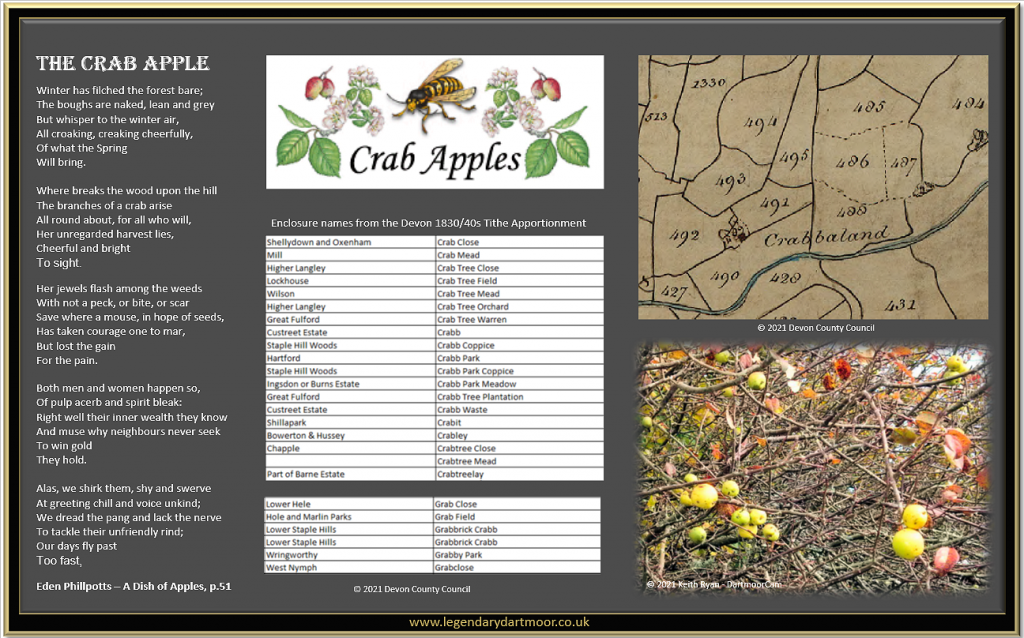
The Crab Apple Tree (Malus sylvestris) is one of the original ancestors of today’s cultivated apple trees. The twigs of the tree sometimes develop little spines thus taking on a ‘crab-like’ appearance which has led to the idea that this is where its name came from. The Crab Apple tree can be described as one of wildlife’s rich larders. Various moth caterpillars thrive on the leaves whilst the early pollen and nectar provides a food source for many insects and especially bees. Lastly the apples are much loved by many birds and mammals such as foxes, badgers, mice and even deer have been known to browse on them. Thanks to the introduction of hybrids such as the Siberian Crab Apple it can be hard to identify true Crab Apple Tees. About the only way is to taste the fruit the sharper and sourer the apple the more likely it is a ‘proper job’.
The poor lowly hedgerow crab apple is today regarded as something of nothing, a waste of bark, all due to the very bitter and sour taste of its fruit when raw. You can see no end of crab apples go to waste each year because nobody can be bothered to pick and cook them because of their initial sour taste. A local saying when describing an ‘acidic’ person was “Eee be zo sours a grab-apple zo’s nowan cud putt wi un a taul.” Crab Apples (known locally as ‘grabs’) were another source of food and could be found in many of the hedgerows, woods and fields of the moor. A fact confirmed by looking at the Devonshire tithe apportionments where you will see field names with the suffix ‘Crab’ or ‘Grab’ as can be seen from the list below along with a farmstead once known as Crabbaland.. Some farmers considered the crab apple as a nuisance plant because when it established itself in a stock hedge as it soon took over and reduced the amount of thorn cover.
In love divination a girl would collect a load of crab apples on ‘Crab Apple Day’ (September 29th). Then on the floor of a loft or secret place form the initials of her lovers with the apples or alternatively carve this initials into the apples. With great excitement she would on Old Michaelmas Day inspect them. The initials or crab apples that were in the best condition indicated the most faithful man in any future relationship. On Dartmoor this was known as “crabbing for husbands.” On the eve of the old twelfth night there was a belief that a string of crab apples had to be hung over the home hearth in order to please the piskies who frequented the house. Some authors contended that the Druids used slithers of the crab apple wood in their divination rites.
Another use of the crab apple tree was to strip its bark in order to make a yellow dye, this old method was often used in cottage industries. The wood is of a hard, course-grained nature and was often used in inlay work, also mallets and screws were made from it. As a fire-wood it radiated a good steady and intense heat whilst giving off a sweet apple aroma. In the late 1800s Crab Apple Blossom perfume was all the rage and was described as being, “delightfully sweet and piquant, with a spring-like freshness.” One of the many adverts in the local papers hailed it as “The perfume of the season. Favourite of ball, drawing room and boudoir.” At one time it was recommended to rub the juice of wild crab apples into scalp which had the effect of keeping the hair healthy and adding a fragrant smell to it.
Crab Apples, along with cinnamon were sometimes added to a tankard of cider along with a hot poker thus making a kind of mulled drink. In some cases unscrupulous cider makers would add crab apples to bulk out their apple crop but if overdone resulted in sour cider and a possible court appearance. In 1907 one William Skinner appeared at Newton Abbot County Court and faced a claim of £8 from Joseph Issac for supplying him with 8 hogsheads of poor quality cider. he denied that any crab apples were using in its production and it was the heat that had spoilt the cider – found guilty and ordered to pay the £8.
A cure for sore throats was to roast a crab apple and then put it in a tankard of ale, having done this it was necessary to ‘bathe’ ones throat in the mixture. I quite like this description as ‘bathing’ ones throat with ale sounds so genteel and innocuous. In cooking the juice of unripened crab apples (known as malic acid or verjuice) would often be used as a type of vinegar and used in some sauces. It was not unusual to use the vinegar for pickling fruits and vegetables. But as always the best use of crab apples I have ever seen is in the making of a very potent wine which when drunk along with cider is sheer glider fuel.

Due to the Second World War food supplies became scarce so other alternatives were soon found many from what would have previously been unthinkable. One such commodity was the crab apple which was used to make wine, jam, jelly etc. In 1941 the Ministry of Food were advocating the use of crab apple cider as a replacement for vinegar (see below). In order to obtain large quantities of crab apples school children were sent out into along hedgerows and fields collecting the apples.
CRAB APPLE WINE
To make crab apple wine you will need the following ingredients plus a lot of patience, and I mean about 2 years worth of it. So first of all trundle off down you nearest hedgerows in search of a crab apple tree which are often found by old pastureland. Ideally you are looking for the yellowish variety that are about the size of a small plum. Tis best to take a stick with you to assist in shaking the higher branches. You will need about 8lbs of crab apples, then when you get them home thoroughly wash them and remove any stalks and leaves. The next process is to crush the apples, if you don’t happen to have an apple crusher then a heavy duty plastic bag and a plank of wood will suffice.
Next, dissolve 1 campden tablet in a gallon of cold water and add the crushed ‘crabbies’ along with a teaspoon of pectozyme. Cover the basin and leave for four days but ensuring that the mash is stirred every day. On the fifth day strain the mash and add 2lbs of sugar, 8ozs of raisins, 1 tsp of yeast nutrient and 1 sachet of champagne yeast. Leave this to ferment for a week then strain and press the raisins and leave to complete fermentation and then bottle. The longer the wine is left the stronger it gets, 18 months should be the minimum amount of time before opening. At Christmas add a stock of cinnamon and mull for a real warming drink.
CRAB APPLE JELLY
Here’s an old Devonshire recipe from 1895. “Pick out all the sound and rosy cheeked apples; cut them in halves, and allow a pint of water to each pound of fruit. Set them over a sharp fire, and let them boil until the apples are quite soft; strain them off through a sieve or a piece of course muslin, pressing them to get all the juice. Measure the juice, and allow 1lb of sugar to each pint of juice. Let this boil quickly, stirring well; when a little dropped on a plate jellies, pour into jam pots; cover while hot.”
CRAB APPLE CIDER
The Ministry of Food, 1941 – “Put the apples in a heat to sweat, and then pick out the stalks, and throw away any fruit that shows signs of rottenness. Beat the apples to a mash, and press the juice through a jelly bag of thick cloth. Put into clean dry bottles and cork well. It will be ready to use in about a month’s time.”
 Legendary Dartmoor The many aspects past and present of Dartmoor
Legendary Dartmoor The many aspects past and present of Dartmoor

